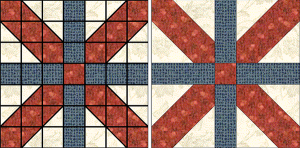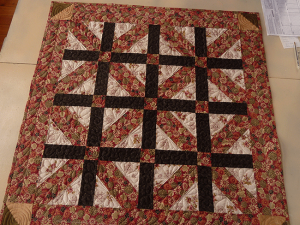 My beginner piecing class focuses on block design and piecing: 4-patch, 9-patch, 5-patch, and 7-patch. I tell my students that if they learn how to draw and sew blocks based on these four grids, they will have enough to make quilts for a lifetime.
My beginner piecing class focuses on block design and piecing: 4-patch, 9-patch, 5-patch, and 7-patch. I tell my students that if they learn how to draw and sew blocks based on these four grids, they will have enough to make quilts for a lifetime.
We draw and sew one sample block for each grid. They learn that by just rotating units in each sample block they can multiply their choices. And then we put the sample blocks together in a simple table runner that looks something like this.
When it comes to the 7-patch block we discuss how the underlying grid is what the design is based on, but that it isn’t necessary (or even smart) to sew each little sub-unit. Sometimes it is better to join them into a bigger unit. In this particular case, we end up with much larger units and this block becomes the easiest one we sew.
My students often complain, however, that this block is boring. And I tell them they need to consider the block within a broader context – set within a quilt. I tell them that thought it seems simple, this block actually produces a secondary design. To prove the point, I decided to put together a quilt sample with this block, and this is the result:
In addition to demonstrating how lovely this block can be in a larger project, I hope they will also be able to appreciate how this simple block provides a great opportunity for some fun free-motion quilting. 🙂




 I am a self-learner. I taught myself to sew and to quilt. And I taught myself how to draw. I am learning how to dye my own fabrics and am dabbling with mixed media. I am a quilt designer and teacher, and design and publish my own line of quilt patterns. With this blog I would like to share the bits and pieces of my life.
I am a self-learner. I taught myself to sew and to quilt. And I taught myself how to draw. I am learning how to dye my own fabrics and am dabbling with mixed media. I am a quilt designer and teacher, and design and publish my own line of quilt patterns. With this blog I would like to share the bits and pieces of my life.